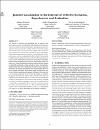Jammer Localization in the Internet of Vehicles: Scenarios, Experiments, and Evaluation
| Author | Hussain, Ahmed |
| Author | Abughanam, Nada |
| Author | Sciancalepore, Savio |
| Author | Yaacoub, Elias |
| Author | Mohamed, Amr |
| Available date | 2023-05-22T11:07:21Z |
| Publication Date | 2022-11-07 |
| Publication Name | ACM International Conference Proceeding Series |
| Identifier | http://dx.doi.org/10.1145/3567445.3567463 |
| Citation | Hussain, A., Abughanam, N., Sciancalepore, S., Yaacoub, E., & Mohamed, A. (2022, November). Jammer Localization in the Internet of Vehicles: Scenarios, Experiments, and Evaluation. In Proceedings of the 12th International Conference on the Internet of Things (pp. 73-80). |
| ISBN | 978-145039665-3 |
| Abstract | The Internet of Vehicles (IoV) paradigm aims to improve road safety and provide a comfortable driving experience for Internet-connected vehicles, by transmitting early warning and infotainment signals to Internet-connected vehicles in the network. The unique characteristics of the IoV, such as their mobility and pervasive Internet connectivity, expose such networks to many cyberattacks. In particular, jamming attacks represent a considerable risk to their performance, as they can significantly affect vehicles’ functionality, possibly leading to collisions in dense networks. This paper presents a new scheme enabling the detection and localization of jamming attacks carried out within an IoV network. We consider several scenarios, e.g., where the Internet-connected vehicles and the jammer are statically positioned, as when parked on a street, moving in the same direction and with variable speeds, and moving in opposite directions. We leverage the physical-layer characteristics of the received signals, particularly the Received Signal Strength (RSS), and devise a solution minimizing the jammer localization error based on a set of antennas deployed on the vehicle. Specifically, we compute the power emitted by the jammer and received by the arrays of omnidirectional antennas and we use such values to estimate the location of the jammer in the previous-cited scenarios. Through an extensive simulation campaign, we provide a thorough study of our algorithm, evaluating the effect of several system and channel parameters on the measurement error. The results obtained for all scenarios show a significant localization accuracy, i.e., ranging from 0.23 meters to 13 meters, depending on the channel conditions. |
| Sponsor | This publication was supported by Qatar University Graduate Assistantship. |
| Language | en |
| Publisher | ACM Digital Library |
| Subject | Internet of Vehicles Jammer Localization Jamming Physical-Layer Security Vehicular Communications Wireless Communications |
| Type | Conference Paper |
| Pagination | 73-80 |
Files in this item
This item appears in the following Collection(s)
-
Computer Science & Engineering [2201 items ]


